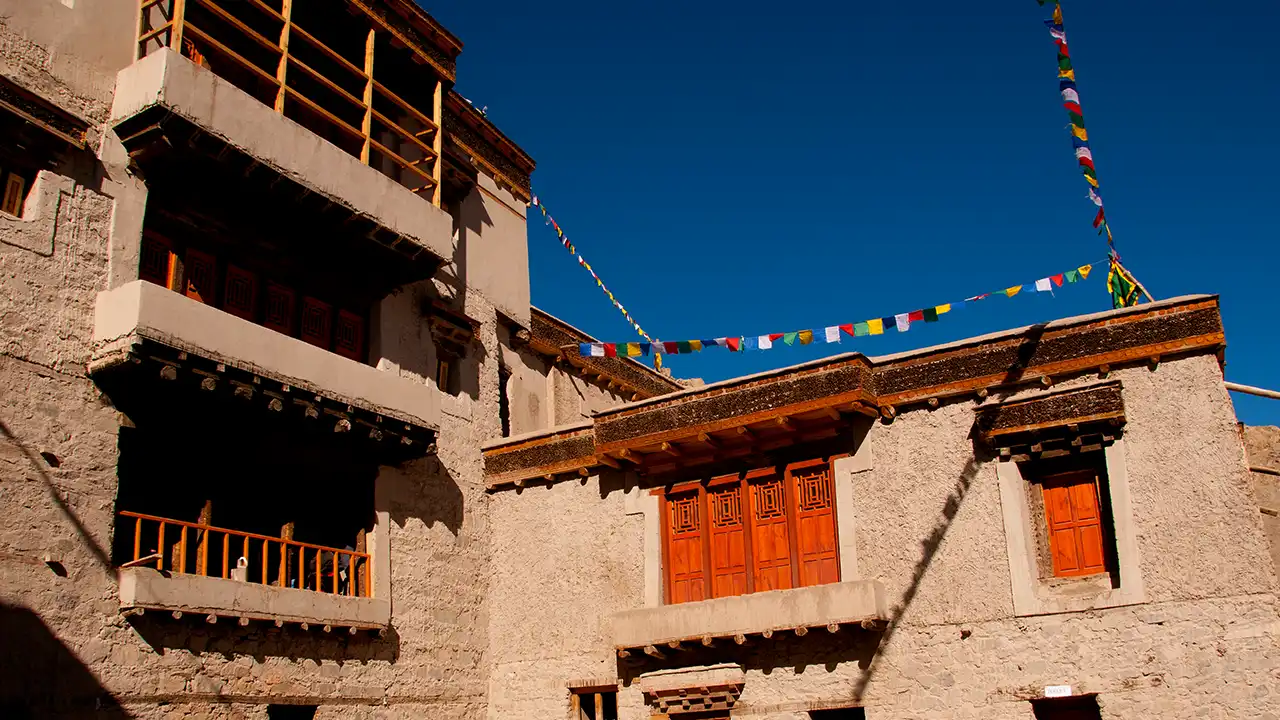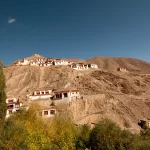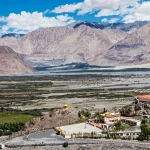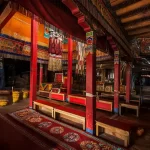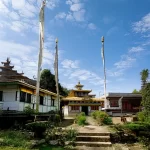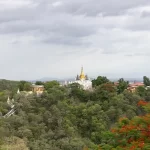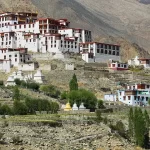In the peaceful village of Alchi along the Indus River in Ladakh, Alchi Monastery is different from all other Buddhist monasteries in the region. It is not perched on a climactic hilltop or high in the mountains as most Ladakhi monasteries are. Rather, Alchi sits unpretentiously at ground level, silently protecting one of the most valuable collections of Buddhist art in the Indian Himalayas.
Dating back to the 10th–11th century, Alchi Monastery is not only among the oldest monasteries in Ladakh but also a surviving rarity of Indo-Tibetan art and architecture. The murals, sculptures, and woodwork are a mix of Indian, Kashmiri, and Tibetan styles reflected in it, making it an invaluable treasure of Himalayan Buddhist heritage.
Historical Background
Alchi Monastery, alternatively Alchi Choskhor, is thought to have been established by the renowned Tibetan scholar and translator Rinchen Zangpo during the period of rule by the King of Guge in western Tibet. Rinchen Zangpo (958–1055 AD) played a significant role in the second diffusion of Buddhism in Tibet and is responsible for the construction of over 100 monasteries and temples in the country.
The monastery’s construction was a turning point in religious and artistic focus, with the importation of Kashmiri craftsmen to create sculptures and murals in what was then a recently converted Buddhist area. Alchi was an important center for the translation of Buddhist scriptures from Sanskrit into Tibetan and for integrating Buddhist iconography with deep Indian art traditions.
Architectural and Artistic Significance
Alchi Monastery is not one building but rather a temple complex of temples, chortens, and quarters for monks. The three key temples of the complex are:
1. Dukhang (Assembly Hall)
This is the oldest part of the monastery that is still employed for ceremonial uses. It includes:
- Delicate woodwork in the form of ornamented beams and pillars.
- Wall paintings describing Buddhist cosmology, life story of the Buddha, and protecting deities.
- Large stucco figures of Buddhas and Bodhisattvas.
2. Sumtsek Temple
The most extensive and impressive building in the complex, the Sumtsek, or “three-tiered building,” has:
Mammoth three-story-tall statues of Avalokiteshvara, Maitreya, and Manjushri, carved and painted in minute detail. Indian art-influenced painted mandalas and thangkas. Walls with paintings of royal patrons, benefactors, and divine beings.
3. Manjushri Temple (Jamyang Lhakhang)
Manjushri, the Bodhisattva of wisdom, is the god worshipped in this temple, which contains:
Four well-painted images of Manjushri in the cardinal directions. Frescoes depicting philosophical and cosmological themes from Buddhist texts. Apart from these, there are other temples and chapels such as the Lotsawa Lhakhang (Temple of the Translator) and the Chortens (stupas) which contain murals and relics.
What makes Alchi stand apart is its fusion of artistic traditions. The paintings reflect Kashmiri and Central Asian influences, with fluid lines, naturalistic facial expressions, and vibrant colours. Unlike the more austere Tibetan art that followed, Alchi’s style is lush, expressive, and ornamental.
Murals and Iconography
Murals of Alchi are some of the oldest remaining paintings in Ladakh and represent masterpieces of Indo-Himalayan Buddhist paintings. The paintings, which were preserved in a near-original condition because of the arid environment, are created with natural pigments and are a rich portfolio of Buddhist divinities.
Some of the recurring themes include:
- The Thousand Buddhas painted in geometric balance.
- Bodhisattvas, clad in royal robes, standing serenely with bejewelled halos.
- Donor portraits, such as queens and kings, were properly depicted presenting alms to the Buddhas.
- Other murals also show evidence of Ajanta and Ellora cave painting and Gandharan school influences, reflecting rich cultural exchanges across the Himalayas.
Spiritual and Cultural Role
Though Alchi is no longer an operational monastery with resident monks, it is still a sacred site. Rituals are carried out from time to time, particularly in local festivals. The monastery is in the custody of the monks of Likir Monastery, who oversee its preservation and maintenance.
Alchi is more than merely a religious sanctuary—it is an existent museum alive with early history of Tibetan Buddhism and cohabitation by Indian Mahayana traditions of the Himalayas. Pilgrims and scholars visit here in hopes of receiving profound silence, consecrated energies, and epoch-less beauty found inside.
To Visit Alchi Monastery
Alchi village lies some 66 kilometers west of Leh, the Ladakh capital, and can be reached easily by road during summer (May to October). The journey is along the scenic path of the Indus River with breathtaking views of Ladakh’s landscape.
Travel Tips:
Best time to visit: May to September when the roads are open and weather is nice.
Timings: The monastery is open every day, typically from 8 AM to 6 PM.
Entrance fee: There is a nominal entrance fee levied for upkeep and preservation work.
Other than visiting the monastery, the traveller can also wander around the quaint village, engage with villagers, and sample Ladakhi hospitality. Apricot orchards and home-stays serving authentic local food are other attractions in the area.
Preservation and Challenges
As an ancient building, Alchi Monastery is subject to the vagaries of time, tourism, and environmental degradation. Conservation efforts through the Archaeological Survey of India (ASI), as well as by UNESCO and other cultural heritage societies, have helped ensure the site’s preservation.
The major concerns are:
- Increased foot traffic and associated humidity and dust damaging fragile murals.
- Climate change resulting in higher rainfall and erosion.
- Insensitivity among some visitors to preservation principles.
- Tourists are asked to maintain the sanctity of the monastery, not use flash photography, and not touch the paintings or sculptures.
Legacy
Alchi Monastery is not only an ancient Buddhist temple—it is a witness to human creativity, piety, and cross-cultural exchange. Its peaceful setting, remarkable art, and storied past make it a cornerstone of India’s Buddhist heritage.
While other Himalayan monasteries stun travelers with their setting, Alchi enchants with what’s inside—a realm of colourful deities, celestial entities, and religious symbols that were painted a thousand years ago and continue to whisper tales to willing ears.
In a hectic world, Alchi provides an instant of calm. It does not merely ask us to marvel at its artwork, but also to reflect on the wisdom, compassion, and vision that guided it.

